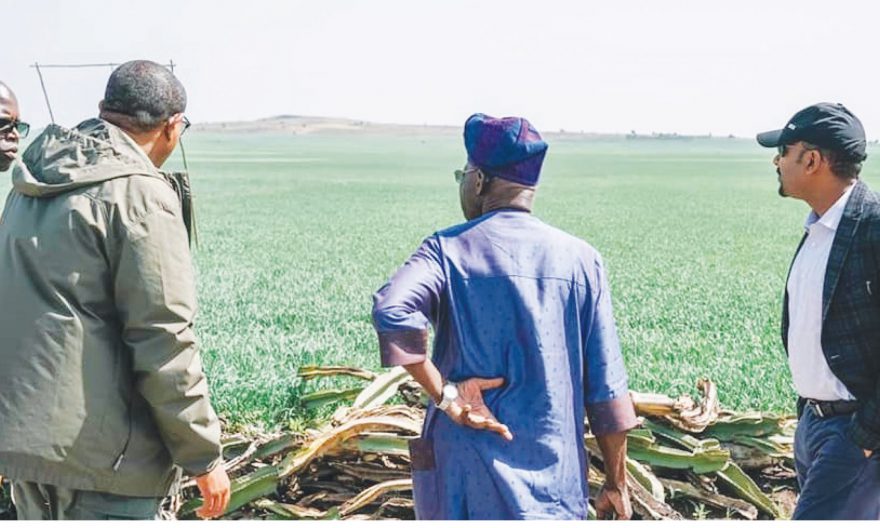
Over the past three years, Ethiopia has provided due attention to wheat production using irrigation schemes of various kinds. The initiative promoted by the incumbent aimed to substitute wheat import through increasing local production capacity applying all agricultural systems.
When comparing the nation’s annual wheat consumption with production capacity, it shows a difference of 15 to 20 million quintal. During the Meher season alone, the country produces up to 50 million quintals of wheat per annum, according to the Ministry of Agriculture.
However, the nation’s annual wheat consumption exceeds 65 million quintals. In order to fill the gap between the demands and supply side, Ethiopia was forced to import 15 to 20 million quintals every year.
Three years ago, Ethiopia launched summer wheat production making use of irrigation targeting lowland areas which remains untilled. Now, this initiative is on hitting its target even if it faces various challenges. To be frank, Ethiopia is on the right track to substitute its wheat demand with local production as of now and onwards. Followed by this progress, the nation has envisaged exporting wheat to neighboring countries.
In 2021, the agriculture sector, especially wheat production became a priority area and gained special concern of the incumbent. The 9.8 billion Birr budget that was allocated for 17 irrigation projects is a showcase for this. Construction of the existing projects and new others are taking place.
Three years ago, the summer wheat production was started with limited capacity as a pilot level and the production was promising. During the first round of the summer production year, the production was around 400 thousand quintals.
In the second year of summer wheat investment, both the area coverage and production increased to a higher level. This year, Ethiopia’s effort of summer wheat production through irrigation continued and this summer over 600 thousand hectares of land is covered by Wheat. By covering this hectare, Ethiopia is expecting to produce enough wheat that can cover the country’s wheat demand and substitute import.
Though facing different internal challenges due to internal conflicts and drought that affects some parts of the country, this summer’s wheat production is a promising step for the country to meet its target goal of substituting wheat import. Ethiopia’s initiative is beyond import substitution, it is tackling poverty by exploiting the available potential at home. Though the investment needs huge resources and is very tough for developing countries, with all the challenges and limitations, Ethiopia is continuing to develop the sector.
Currently, the world, especially Africa is facing serious wheat shortages and price rising following the Russia-Ukraine war since most countries depend on importing wheat from Russia and Ukraine. Now, following the war between the two countries, the price of wheat and bread is mounting immediately in the world market and especially Africa is facing serious problems in this regard.
This situation is an alarming situation for most developing countries that remain dependent on importing basic goods from abroad. These countries are importing wheat and other grains from abroad with billions of dollars. Now, the chance to get the product becomes tough and countries are badly affected by the Russia-Ukraine war.
This is an indicator and a signal for African countries to find new ways. Giving due attention for local agricultural development must be the only solution for Africa and other developing countries. The only solution for African countries to minimize the influences of their markets by external developments is focusing on local agricultural production and regional, continental and international partners should focus on supporting local initiatives of each country. Blaming the Russia-Ukraine war for the current wheat and other grain products shortage must come to an end and sustainable solutions must be initiated everywhere to produce basic agricultural goods.
So far, Ethiopia’s wheat production initiative aims to substitute the importing amount with local production to balance the local demand-supply gap. But, following the investments during the past three years, Ethiopia is looking to increase its production even beyond self-sufficiency. Ethiopia has the capacity of wheat production even to feed Africa and heads of different continental and international organizations are praising Ethiopia’s potential, commitment and commenting to develop its production for export purposes.
Recently, the World Bank country representative to Ethiopia and other heads of continental and international organizations visited summer wheat farming activities in Jimma and Arsi Zones of Oromia Regional State and appreciated the country’s efforts in wheat farming and vowed the country’s potential. Following their visit, those heads of different organizations stated that Ethiopia has a full potential to produce wheat that can fulfill Africa’s wheat demand and express their hopes that Ethiopia may start exporting wheat to its neighbors early.
Recently, the African Development Bank Group (AfDB) President stated that Ethiopia’s wheat production has the potential to export over 1.5 million to two million metric tons to neighboring countries. During his speech at the closing ceremony of the 2022 Annual Meeting in Accra, Ghana, the AfDB President Akinwumi Adesina noted he learnt from Premier Abiy Ahmed that Ethiopia covers over 650 thousand hectares of land by wheat and produced 2.6 million metric tons of wheat crops.
“Ethiopia did not import wheat this year. Next year, we will cultivate two million hectares of wheat and we expect to export at least 1.5 million to two million metric tons to Kenya and Djibouti.” Adesina quoted the Prime Minister Abiy Ahmed’s saying. To realize the country’s effort and to exploit its available production potential, Ethiopia’s initiative needs further support mainly in mechanizing agriculture and in expanding the irrigation coverage. To realize Ethiopia’s struggle against poverty, it needs development partners’ support mainly to increase the country’s irrigation and mechanization farming efforts.
Ethiopia is allocating tens of billions of budget to transform agriculture and to expand the coverage of irrigation. But, for developing countries it is difficult to allocate enough budgets to transform the sector shortly and capacity limitation remains a serious challenge for Ethiopia like other developing countries. Though the country is rich in rivers, irrigation consumes huge capital.
For true development and to tackle poverty to bring sustainable change, continental and international development organizations should focus on supporting local agricultural initiatives like Ethiopia’s summer wheat production.
In this regard, the World Bank, the African Development Bank and other continental and international organizations can play crucial roles in providing development support and long-term loans to support such productive agricultural investments. Africa’s self-sufficiency struggles must be supported instead of focusing on aids for daily consumption.
Donations must meet the target if the intention is to support the people. So far, the aid did not change the livelihood and income of the African people and that is why poverty continues to be the top problem of the continent. Hence, there must be a paradigm shift in supporting Africa. Ethiopia’s wheat farming effort is among the exemplary local efforts in this regard and continental and international development partners should support similar initiatives in Africa. This is the only way to realize African transformation and to meet the target of poverty reduction in the continent.
BY DARGIE KAHSAY
THE ETHIOPIAN HERALD TUESDAY 14 JUNE 2022




